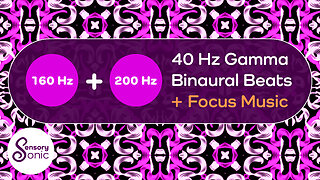Premium Only Content

222 Hz Isochronic Tones With Atmospheric Relaxation Music | 30 Minutes Of Healing Sounds
This relaxing yet uplifting video combines continuous 222 Hz isochronic tones with atmospheric music with a gentle beat. At 30 minutes, it's perfect for a longer meditation or as background music for when you want to concentrate.
#isochronic #isochronictones #222 # 222hz #brainwaveentrainment #meditation #meditationmusic #isochronicbeats #relaxation #relaxationmusic #relax #soundhealing #soundhealingmeditation #solfeggio #solfeggiofrequencies #angelnumbers #angel #healing #concentration
---
Isochronic tones are a form of brainwave entrainment that involves rhythmic audio pulses. These tones consist of evenly spaced, distinct sound pulses that synchronize the brainwaves to a specific frequency. When you listen to isochronic tones, your brainwave activity tends to align with the frequency of the tones.
The working principle behind isochronic tones is based on the brain's natural tendency to synchronize with external rhythmic stimuli. This phenomenon, known as brainwave entrainment, can influence your mental state and potentially induce various effects.
Benefits of Isochronic Tones:
Relaxation: Isochronic tones can help promote relaxation and reduce stress levels. Listening to these tones may trigger the production of calming brainwave patterns, such as alpha and theta waves, which are associated with a relaxed state of mind.
Focus and Concentration: Isochronic tones in the beta frequency range (around 14-30 Hz) can enhance focus and concentration. These tones stimulate the brain to produce beta waves associated with alertness and cognitive functioning.
Meditation and Mindfulness: Many individuals use isochronic tones during meditation or mindfulness practices. The tones can help guide the mind into a deeper meditative state by promoting the production of theta and delta brainwaves associated with increased introspection and a sense of tranquillity.
Sleep Improvement: Isochronic tones in the delta frequency range (around 0.5-4 Hz) are often used to promote deep sleep and combat insomnia. These tones encourage the brain to generate delta waves associated with deep relaxation and restorative sleep.
Side Effects and Considerations:
Sensitivity: Some individuals may be more sensitive to isochronic tones than others. Start with lower volume levels and gradually increase if desired. If you experience any discomfort or adverse effects, discontinue use.
Potential Disruption: Isochronic tones may not suit everyone in all situations. Avoid listening to them while operating machinery or engaging in tasks that require your full attention. They are best used in a controlled environment where you can relax and focus without distraction.
Individual Variations: The response to isochronic tones can vary from person to person. Some individuals may experience the desired effects immediately, while others may require regular and consistent use over time to notice changes. Results can also depend on individual brainwave patterns, state of mind, and personal receptiveness.
Lack of Scientific Consensus: While there is anecdotal evidence and some studies exploring the potential benefits of brainwave entrainment, the scientific community does not universally endorse or validate the efficacy of isochronic tones. More research is needed to establish their effectiveness and understand their mechanisms fully.
It's always advisable to consult a healthcare professional or expert in brainwave entrainment before incorporating isochronic tones into your routine, especially if you have any underlying medical conditions or concerns.
-
 29:59
29:59
Sensory Sonic
11 months ago40 Hz Gamma Binaural Beats With Hypnotic Focus Music | Ideal For Study & Work Productivity
1.21K -
 LIVE
LIVE
The Jimmy Dore Show
3 hours agoNYPD’s Mangione Perp Walk an EPIC FAIL! Biden’s Last SCREW JOB to Workers! w/Carol Roth & Paul Stone
13,968 watching -
 LIVE
LIVE
Edge of Wonder
4 hours agoChristmas Mandela Effects, UFO Drone Updates & Holiday Government Shake-Ups
286 watching -
 LIVE
LIVE
Mally_Mouse
2 hours agoLet's Play!! -- Friends Friday!
474 watching -
 LIVE
LIVE
LFA TV
22 hours agoObama’s Fake World Comes Crashing Down | Trumpet Daily 12.20.24 7PM EST
771 watching -
 LIVE
LIVE
2 MIKES LIVE
1 hour ago2 MIKES LIVE #158 Government Shutdown Looms and Games!
271 watching -
 LIVE
LIVE
The Big Mig™
6 hours agoVeteran, Patriot, Leader, Author Allen West joins The Big Mig Show
2,099 watching -
 1:06:47
1:06:47
The Amber May Show
22 hours ago $0.46 earnedBloated CR Failed | What Did The View Say Now? | Who Kept Their Job At ABC| Isaac Hayes
6K -
 59:29
59:29
State of the Second Podcast
4 days agoAre We Losing the Fight for Gun Rights? (ft. XTech)
21.6K3 -
 1:00:10
1:00:10
The Nima Yamini Show
3 hours agoTragedy in Germany 🇩🇪 Suspected Terror Attack at Christmas Market – LIVE Updates from Germany
26.3K25